
Robotically fabricated carbon-fibre pavilion opens at the V&A
由专筑网Ann,刘庆新编译
由斯图加特大学研究团队设计的由机械编织而成的碳化纤维艺术装置日前在维多利亚和阿尔伯特博物馆(V&A博物馆)内进行展示。
A robotically woven carbon-fibre pavilion developed by a team from the University of Stuttgart has been erected in the courtyard of London's V&A museum as part of a season of engineering events (+ slideshow).
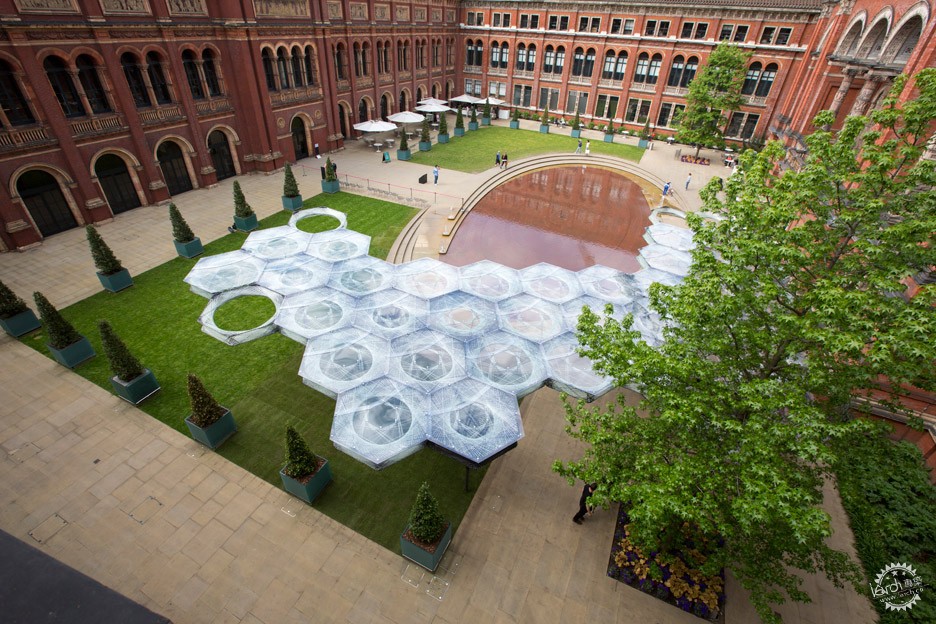
“翅羽丝会馆”由40个各不相同的六边形构件组成,每个六边形都采用了透明的玻璃纤维和黑色碳纤维材料,由机械制造而成。
每个单元的网状形态都根据甲虫前翅的纤维状结构进行设计——命名为翅鞘。
该装置由建筑师和研究员AchimMenges与建筑师 Moritz Dörstelmann、结构工程师Jan Knippers 和环境工程师Thomas Auer合作设计。
The Elytra Filament Pavilion comprises 40 unique hexagonal components that have been robotically fabricated from a combination of transparent glass fibre and black carbon fibre.
The web-like design of each component is based on the fibrous structure of beetle's forewings – named elytra.
The pavilion is designed and produced by architect and researcher AchimMenges, in collaboration with architect Moritz Dörstelmann, structural engineer Jan Knippers and climate engineer Thomas Auer.

它是目前正在进行的斯图加特大学参数化设计研究所(由Menges负责)和建筑结构研究所(由Knippers负责)的仿生学研究项目的一部分。
“这是一项有活力的研究” AchimMenges在展馆开幕式上表示,“纤维增强塑料是现阶段发现的最令人兴奋的材料之一——自然界也利用纤维状复合材料,这一发现令人欣喜。”
It forms part of an ongoing research project looking at biomimicry in design by the University of Stuttgart's Institute of Computational Design – directed by Menges – and the Institute of Building Structures and Structural Design – led by Knippers.
"This is a live research project," said AchimMenges at the opening of the pavilion today. "One of the most exciting materials we've found are fibre-reinforced plastics – it's also interesting to see that nature also uses fibrous composites."
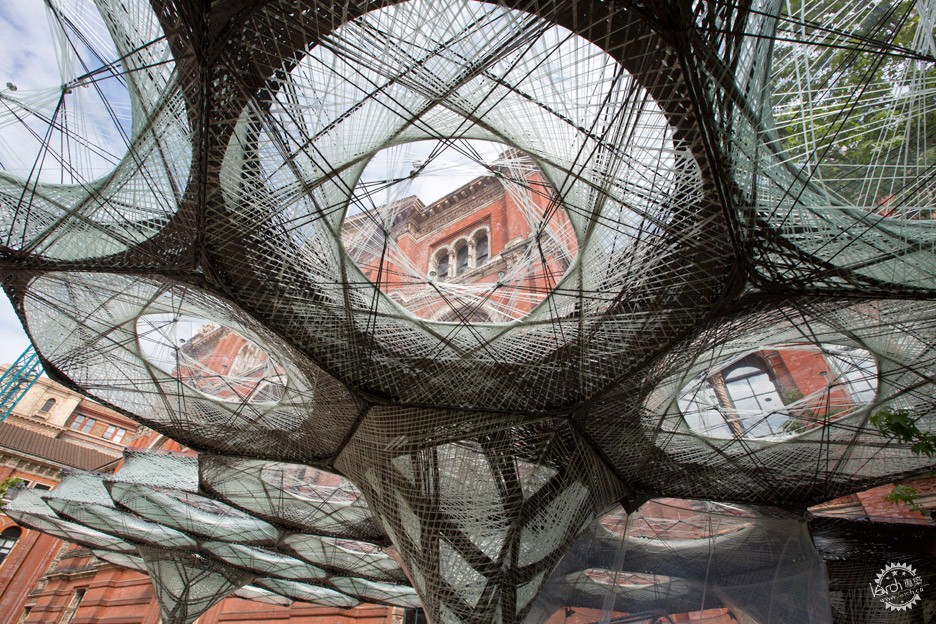
“这是设计与工程相结合的范本。”他补充道,并强调数字设计和机械制造业的发展正在改变着工程领域。
“我想我们正在经历一个转型时期,第四次工业革命。”
"This is very much a showcase of how design and engineering come together," he added, claiming that developments in digital design and robotic construction are transforming the field of engineering.
"I think we're experiencing another paradigm shift, a fourth industrial revolution."
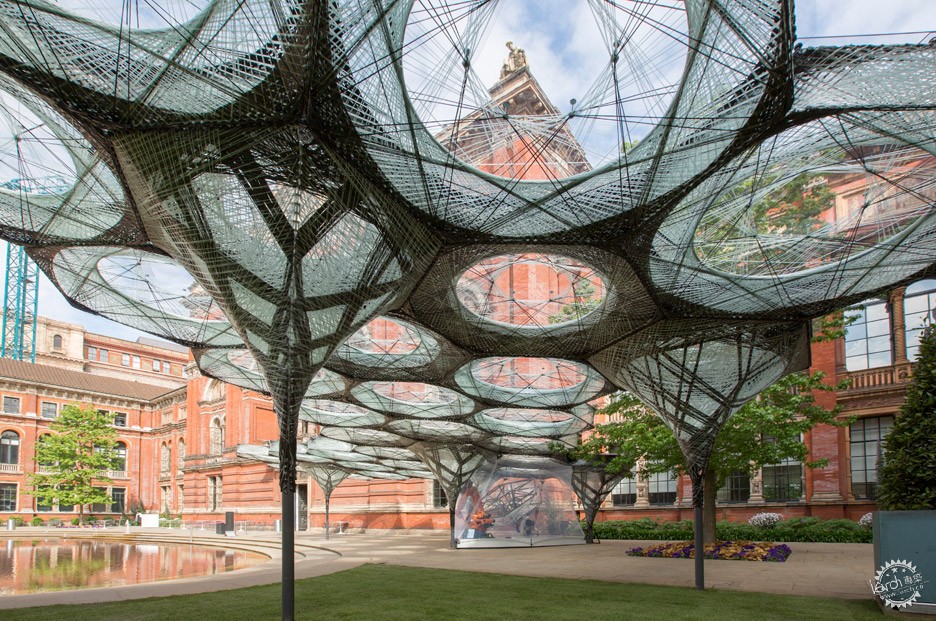
整个结构面积达200平方米,其中的每一部分都由漏斗状的结构支撑,由单向的树脂包层纤维组成,重量仅45千克。
玻璃碳纤维在形成坚硬的六边形结构之前,由机械手臂操控,缠绕在金属框架上固化成型。
Each piece of the 200-square-metre structure, which is supported by funnel-shaped legs, is formed by a single length of resin-coated fibre and weighs just 45 kilograms.
The glass and carbon fibre is wound around metal formwork by a robotic arm, before being cured to form the rigid hexagonal elements.
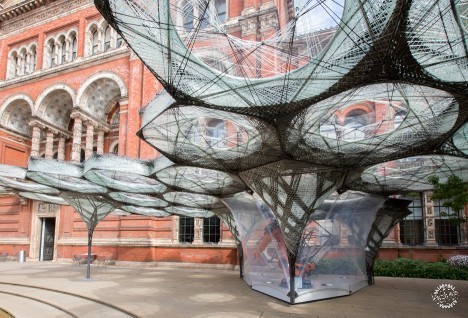
在展览馆,一个机械制造的透明膜状结构也将成为装置的新元素进行展览,展览将一直持续至2016年11约6日。
Dörstelmann 对Dezeen表示,装置的支撑点是经过数据计算得出的,这些数据由遮篷的玻璃纤维内置的光纤传感器进行采集。
An on-site robotic contained within a transparent membrane will produce new elements of the pavilion throughout the show, which will run until 6 November 2016.
The placement of these pieces will be determined by data collected by fibre optic sensors embedded in the canopy's glass fibres, Dörstelmann told Dezeen, and will see the pavilion sprawl across the courtyard.
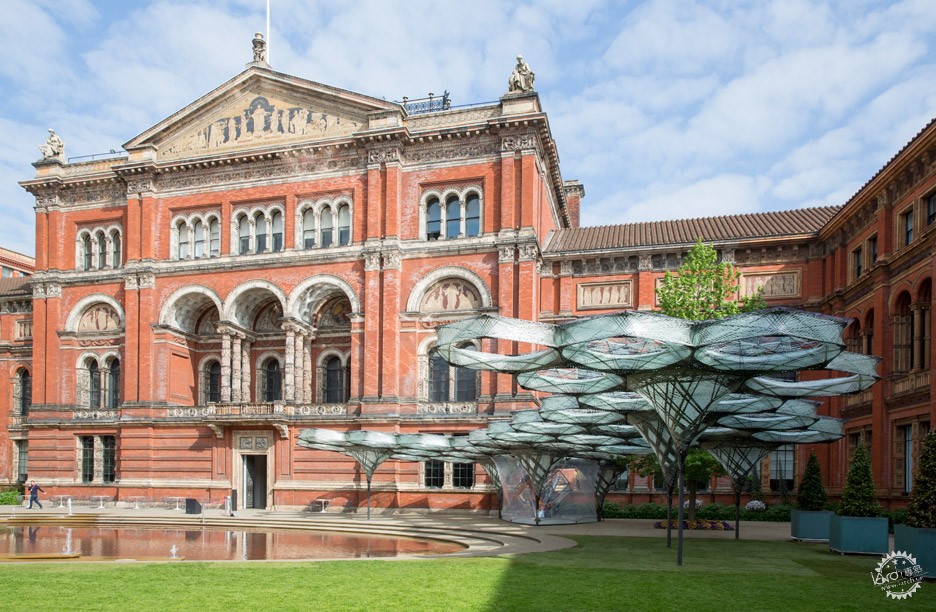
每部分构件的尺度并非受到材料的限制,而是取决于V&A博物馆狭窄的入口通道。
团队相信这一材料能够建造更大跨度的结构。
Menges曾对Dezeen表示,碳纤维是建筑领域上最具开发潜力的资源,并认为机械能够通过编程利用碳纤维复合材料建造体育馆的屋顶部分。
The scale of each segment is determined not by the limits of the material, but by the narrow doors of the historic V&A building.
But the team believes the material could be used to produce much larger spanning structures.
Menges previously told Dezeen that carbon fibre is architecture's biggest untapped resource, and claims that robots could be programmed to build stadium roofs using the fibrous building material.
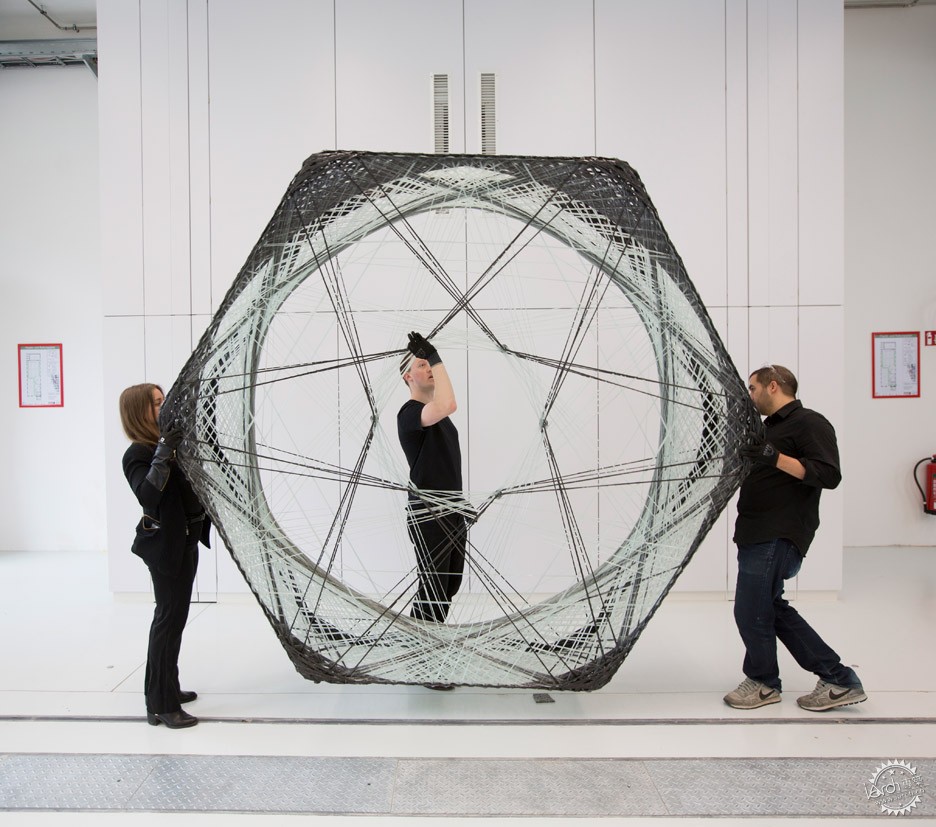
它是目前正在进行的斯图加特大学参数化设计研究所仿生学研究项目的一部分/The pavilion forms part of an ongoing research project by the University of Stuttgart team looking at biomimicry in design
“材料真正的内在性能还没有完全开发出来,我们还没有脱离新材料模仿旧材料的阶段。”他在上个月参观斯图加特研究小组时表示。
“这是一项非常新的技术,还未被完全发掘并商业化。”
翅鞘亭的建造就应用了这一技术,用于 Menges和Knippers与学生们共同举办的每年一次的装置展览中——其中的一个项目的灵感来自于包覆着甲虫翅膀的壳体。
在今年的展示中,基于对海胆类生物的壳体研究,研究团队设计了一个由机械拼接而成的纤薄的层积材结构,早在2013年,研究小组就曾以龙虾结构为原型建造了碳纤维的茧状装置。
"The genuine possibilities inherent in the material are not fully tapped into," he said during a tour of his Stuttgart-based research unit last month. "We haven't left that phase where these new materials are mimicking old materials."
"It's a very new technology so nobody has picked it up and commercialised it."
The techniques used to produce the Elytra Filament Pavilion have emerged from an annual series of research pavilions created by Menges and Knippers with students – including one based on the shells encasing the wings of beetles.
This year's edition, based on research into the shells of sea urchins, is anarching laminated timber structure that has been industrial sewn together by a robot, while in 2013 the units developed a carbon-fibre pod that takes a lobster's exoskeleton as its point of reference.
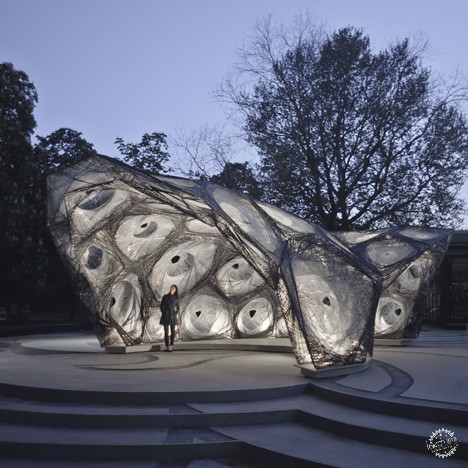
它经历了一系列的碳纤维实验,包括基于甲虫壳体的轻质结构测试/It follows a series of experiments in carbon fibre, including this lightweight structure based on a beetle's shell
这些前卫的项目出自斯图加特大学与苏黎世联邦理工学院的联合研究,获得了包括 Wolf D Prix 和BIG事务所Kai-Uwe Bergmann 在内的多名建筑师的支持,进行了一轮轮的机械建造实验。
伦敦AA建筑学院最近公布了新理学硕士设计及课程,在现有的课程设置上更加专注于机械技术及其在建造上的应用。
Menges将会联合预计2016年6月18日开幕的 V&A博物馆展示周,共同举办一场关于仿生、设计和工程的研讨会。
展览以工程装置艺术为主题,将会包括英国结构工程师艾拉普的回顾展示、Arupgroup之后的20世纪工程师的作品,一些英国公司包括AKT II, Atelier One, BuroHappold, Expedition Engineering和Jane Wernick Associates等的杰出的艺术装置。
The pioneering research carried out at the University of Stuttgart, coupled with that taking place at ETH Zurich, is being championed by architects including Wolf D Prix and BIG's Kai-Uwe Bergmann and has led to a wave in robotic construction.
London's Architectural Association School recently announced its new MSc Design & Make course, which will run alongside its existing programme to focus on robotic technologies and their application in timber construction.
Menges will lead a symposium about biomimicry, design and engineering in conjunction with the V&A Engineering Season, which opens on 18 June 2016
The season of engineering-themed events will include the first major retrospective of Ove Arup, the 20th-century engineer behind the Arupgroup, and highlight projects by British engineering firms including AKT II, Atelier One, BuroHappold, Expedition Engineering and Jane Wernick Associates.
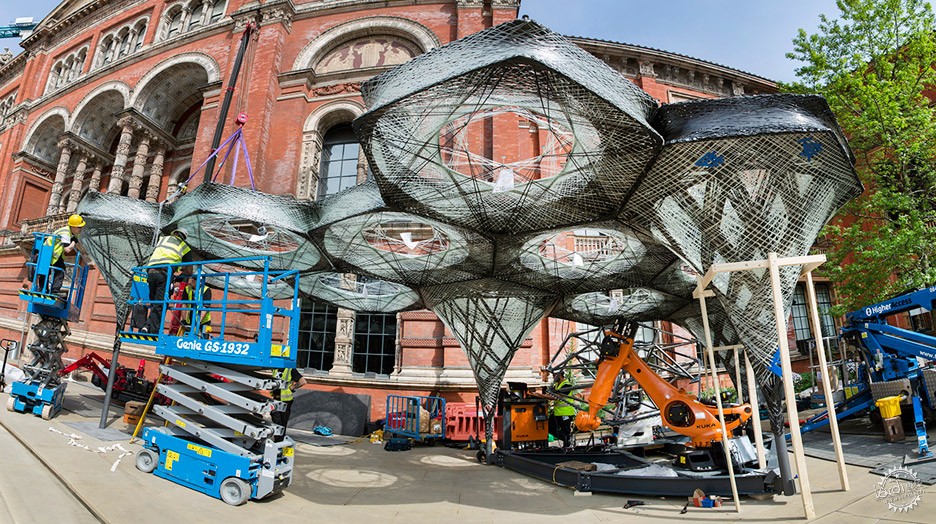
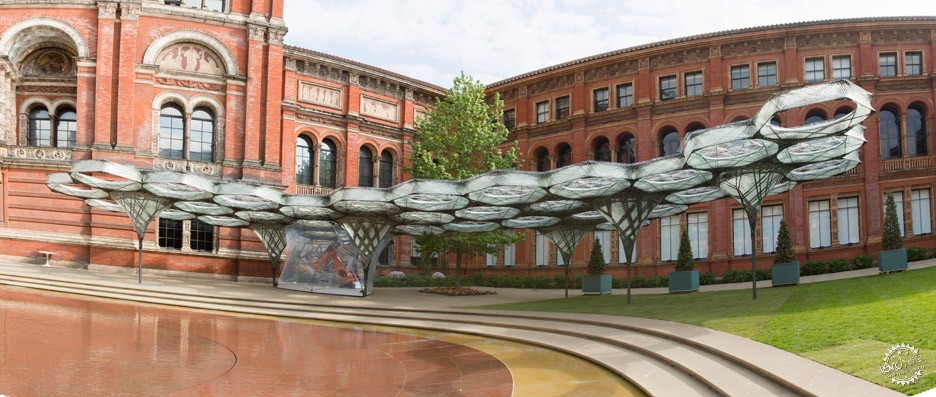

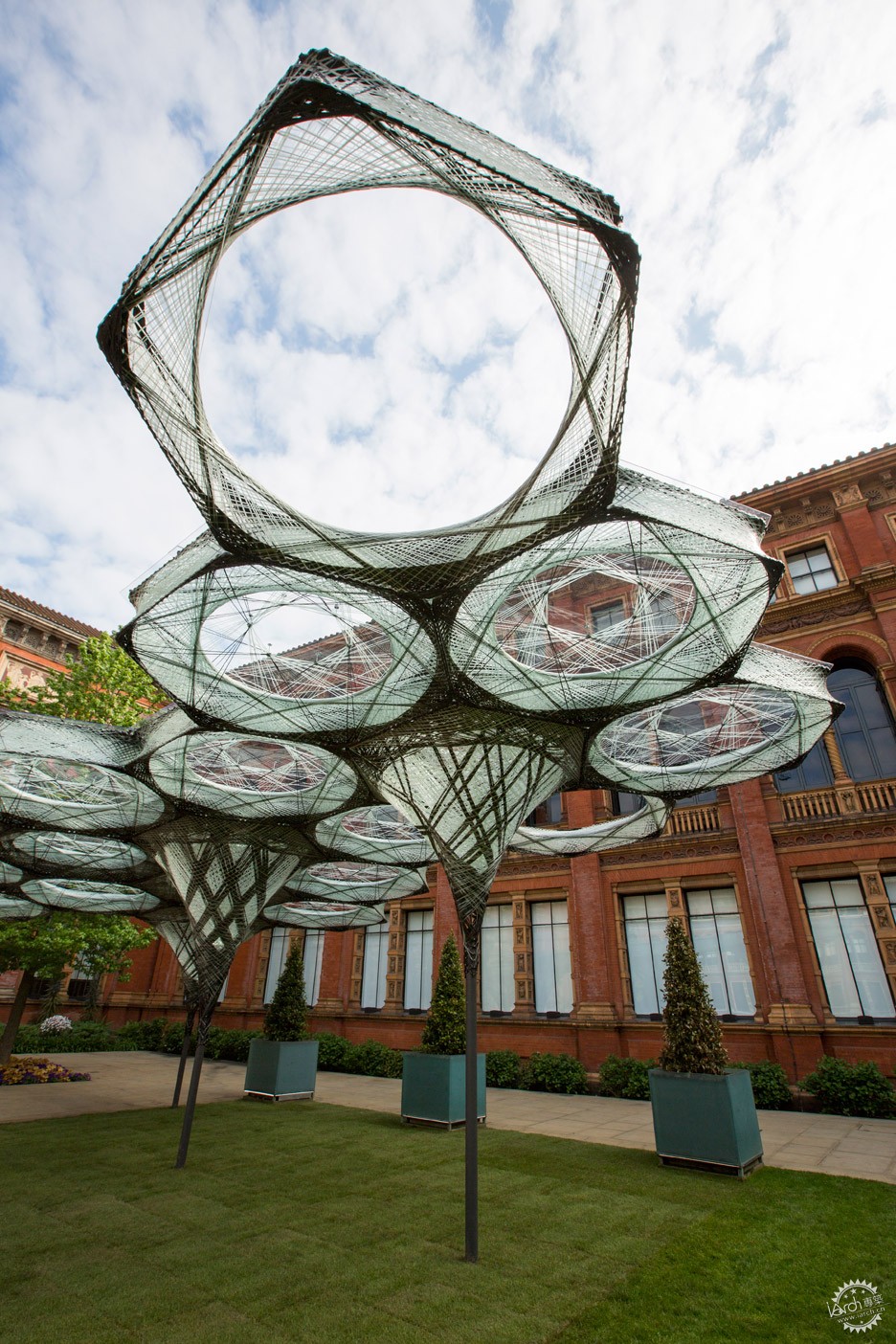
出处:本文译自www.dezeen.com/,转载请注明出处。
|
|
